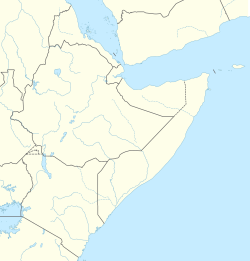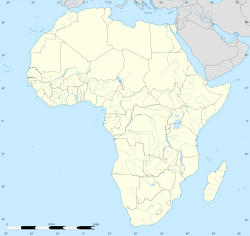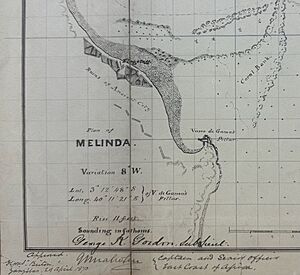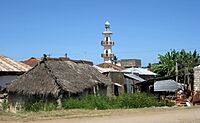Malindi facts for kids
Quick facts for kids
Malindi
|
|
|---|---|
|
Municipality
|
|
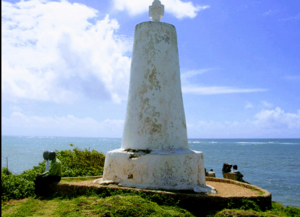
Vasco da Gama Pillar and Indian Ocean
|
|
| Country | |
| County | Kilifi County |
| Founded | 13th – 14th century |
| Re-settled | 1861 |
| Population
(2019)
|
|
| • Total | 119,859 |
| Time zone | UTC+3 (EAT) |
Malindi is a town on Malindi Bay at the mouth of the Sabaki River, lying on the Indian Ocean coast of Kenya. It is 120 kilometres northeast of Mombasa. The population of Malindi was 119,859 as of the 2019 census. It is the largest urban centre in Kilifi County.
Overview
Tourism is the major industry in Malindi. The city is popular among Italian tourists. Notable heritage sites include the Vasco da Gama Pillar, the Portuguese Chapel, the House of Columns and the Malindi Museum Heritage Complex.
Malindi is served with a domestic airport and a highway between Mombasa and Lamu. The nearby Watamu town and Gedi Ruins (also known as Gede) are south of Malindi. The mouth of the Sabaki River lies in northern Malindi.
The Watamu and Malindi Marine National Parks form a continuous protected coastal area south of Malindi. The area shows classic examples of Swahili architecture. The majority of Malindi's population is Muslim.
Malindi is home to the Malindi Airport, and Broglio Space Centre (the previous San Marco Equatorial Range).
History

Malindi developed as part of the emerging Swahili Civilization in the 5th–10th centuries. Bantu-speaking farmers moved into the area, where they smelted iron, built timber and wattle houses thatched with palm leaves, spoke a local dialect of kiSwahili, and engaged in regional and sometimes long-distance trade. The resurgence of the Indian Ocean trade networks at the end of the first millennium led to larger settlements, increased long-distance trade, and greater social complexity. Beginning in the 11th century, the Swahili along the coast were acting as middlemen for Somali, Egyptian, Nubian, Arab, Persian, and Indian traders. They began building walled towns, coral houses, and elites converted to Islam, often speaking Arabic.
The Malindi Kingdom appears to have been formed around the 9th century AD and to have grown powerful in the two centuries before Vasco da Gama ushered in Portuguese colonization of the region, the latter leading to the decline of the civilization. The city of Malindi, founded around 850 AD, was in a somewhat more northerly location than the modern city, and appears to have been destroyed around 1000 AD. There are sparse signs of habitation for the next two centuries, then recovery and prosperity in the 1200s.
The first written reference to the present-day Malindi likely comes from Abu al-Fida (1273–1331), a Kurdish geographer and historian. He wrote that Malindi was situated to the south of the mouth of a river which began in a mountain hundreds of miles away. This mountain may be Mount Kenya, where the Galana River rises. Thus, Malindi has existed as a Swahili settlement since at least the 13th century.
Once rivalled only by Mombasa for dominance in this part of East Africa, Malindi has traditionally been a port city. In 1414, the town was visited by the fleet of the Chinese explorer Zheng He. Malindi's ruler sent a personal envoy with a giraffe as a present to China on that fleet.
The Portuguese explorer Vasco da Gama met Malindi authorities in 1498 to sign a trade agreement and hire a guide for the voyage to India, when he erected a padrão known today as the Vasco da Gama Pillar. Vasco da Gama was given a warm reception from the Sultan of Malindi, which contrasted with the hostile reception he encountered in Mombasa. It is a popular tourist attraction for both local and international tourists.
In 1498 Malindi was a prosperous town with a population between 5,000 and 10,000. The majority of the population was Muslim by this period, having converted largely between the 13th and 14th centuries. Like other Mediaeval Swahili towns, the ruling class or wazee was made up of the heads of the wealthiest patrician families. Similar to other Bantu-speaking peoples, these clan leaders elected a mwenye mui or chief who spoke on behalf of the patricians. The Portuguese mistakenly titled these individuals "Kings," misunderstanding the nature of Swahili political organization. The wazee spoke both Swahili and Arabic, and claimed mythological origins from the East, most often Persia.
Malindi's main source of prosperity was the export of ivory and rhino horns as well as exporting agricultural products such as coconuts, oranges, millet and rice. In the years before the arrival of the Portuguese, Malindi was a regional power but lagged significantly behind the two greatest states, Mombasa and Kilwa. When, in 1499, the Portuguese established a trading post in Malindi that served as a rest stop on the way to and from India, they were eagerly welcomed by the wazee who sought to use the Portuguese military might to establish themselves over their rivals in Mombasa. In 1500, King Dom Manuel I offered vassal status to Malindi. Malindi supported Portugal's successful efforts to conquer Kilwa and Mombasa in 1505. In 1502 the Portuguese established a factory in Malindi, which lasted till 1593. The decline of Kilwa and Mombasa led to Malindi's flourishing. Malindi grew as other Swahili, as well as Arab, Persian, and Indian, merchants, craftsmen, sailors, and labourers flocked to newly powerful city.
Malindi remained the centre of Portuguese activity in eastern Africa until 1593 when the Portuguese moved their main base to Mombasa. This was through the help of the Segejus and the Sheikh of Malindi. As the major East African ally of Portugal along the Swahili Coast, Malindi supported Portugal's successful efforts to conquer Kilwa and Mombasa. The two Swahili city states often had feuds with each other as they fought for dominance over the trade. In his military struggles against Mombasa, the Sheikh of Malindi allied with the Portuguese and Segeju to take over the city. In 1592, the Segeju occupied Mombasa, eventually surrendering it to the Sheikh of Malindi. The Sheikh then moved his court from Malindi to Mombasa and ruled from 1593 to 1630. During this time, he invited his allies, the Portuguese, to build a Garrison and they dominated the city.
After the Portuguese departed the town gradually declined until it almost disappeared by the end of 17th century. An 1823 United Kingdom Admiralty chart of 'Melinda' declared that at that time there were 'no vestiges of the once splendid city of Melinda' apart from Vasco da Gama's Pillar. In 1845 Ludwig Krapf visited the town and found it overgrown by vegetation and uninhabited. A Portuguese chapel with a graveyard was built before 1542 when Francis Xavier visited the town. Many buildings of Swahili architecture survive, including the Juma Mosque.
Malindi was refounded by Sultan Majid of Zanzibar in 1861 and until the end of 19th century served as a centre of the slave trade. A plan of the town in 1873 indicates the area of occupation by that time. In 1890 Malindi came under British administration and slave trade and slavery were abolished. This act led to a significant decline in agricultural production. Outside agriculture there were few industries in Malindi at the beginning of the 20th century; among them were making mats and bags, crushing sesame seeds for oil and producing a Swahili drink called tembo. Malindi was officially made a town in 1903. Ten years later its population stood at around 1148 and included 843 Africans, 230 Arabs, 67 Asians and 8 Europeans.
Malindi experienced a trade boom between the end of the World War I and 1925, when a famine occurred. Exports to foreign ports grew to £26,000 by 1924. Europeans started to return to Malindi in the 1930s, buying land from Arabs. Some of them like Commander Lawford opened the first hotels, which became the foundation of the future tourist industry. During World War II Malindi was one of only two towns in East Africa bombed by the Italians. This happened on 24 October 1940, and after this event allied troops were stationed in the town until the end of the war. After World War II Malindi began developing into a resort.
Climate
Malindi has a tropical dry savanna climate (Köppen climate classification As).
| Climate data for Malindi (extremes 1892–present) | |||||||||||||
|---|---|---|---|---|---|---|---|---|---|---|---|---|---|
| Month | Jan | Feb | Mar | Apr | May | Jun | Jul | Aug | Sep | Oct | Nov | Dec | Year |
| Record high °C (°F) | 34.0 (93.2) |
34.0 (93.2) |
34.5 (94.1) |
39.0 (102.2) |
32.2 (90.0) |
30.5 (86.9) |
30.8 (87.4) |
29.8 (85.6) |
32.0 (89.6) |
32.0 (89.6) |
34.1 (93.4) |
33.0 (91.4) |
39.0 (102.2) |
| Mean daily maximum °C (°F) | 30.8 (87.4) |
30.9 (87.6) |
31.8 (89.2) |
31.1 (88.0) |
28.8 (83.8) |
27.9 (82.2) |
27.3 (81.1) |
27.4 (81.3) |
28.3 (82.9) |
29.6 (85.3) |
30.5 (86.9) |
30.8 (87.4) |
29.6 (85.3) |
| Mean daily minimum °C (°F) | 23.3 (73.9) |
23.5 (74.3) |
23.9 (75.0) |
24.2 (75.6) |
23.4 (74.1) |
22.6 (72.7) |
22.0 (71.6) |
21.6 (70.9) |
21.7 (71.1) |
22.2 (72.0) |
22.8 (73.0) |
23.4 (74.1) |
22.9 (73.2) |
| Record low °C (°F) | 20.0 (68.0) |
19.6 (67.3) |
21.0 (69.8) |
20.8 (69.4) |
21.0 (69.8) |
19.5 (67.1) |
18.6 (65.5) |
17.0 (62.6) |
17.2 (63.0) |
19.0 (66.2) |
19.0 (66.2) |
21.0 (69.8) |
17.0 (62.6) |
| Average precipitation mm (inches) | 11 (0.4) |
17 (0.7) |
36 (1.4) |
163 (6.4) |
298 (11.7) |
154 (6.1) |
91 (3.6) |
64 (2.5) |
47 (1.9) |
68 (2.7) |
75 (3.0) |
35 (1.4) |
1,059 (41.7) |
| Average precipitation days | 2 | 2 | 3 | 11 | 17 | 12 | 12 | 9 | 7 | 6 | 6 | 3 | 90 |
| Source 1: World Meteorological Organization | |||||||||||||
| Source 2: Meteo Climat (record highs and lows) | |||||||||||||
Local governance
Malindi now falls under Kilifi County as per the administrative changes in the new constitution passed in August 2010. Malindi forms a municipal council with the following thirteen wards: Barani, Ganda/Mkaumoto, Gede, Gede North, Gede South, Kijiwetanga, Madunguni, Malimo, Malindi Central, Malindi North, Maweni, Shella, and Watamu Town. All of them are located within Malindi Constituency.
Gallery
See also
 In Spanish: Malindi para niños
In Spanish: Malindi para niños



